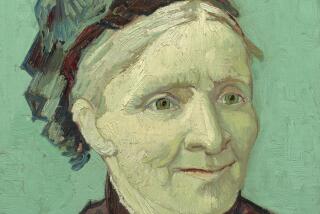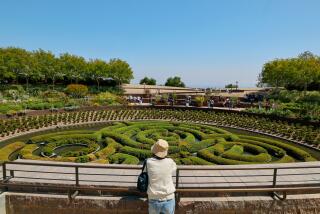A Painter at Work in Sacred Spaces
- Share via
The 17th century painter Pieter Saenredam came up with a very odd, very clever idea. In his native Holland, the Protestant Reformation had led to the whitewashing of church interiors, as well as the wholesale removal of their religious paintings, statues and stained glass windows as wicked and idolatrous. So, rather than make paintings for churches, which European artists had done for centuries, Saenredam began to make paintings of churches. The resourceful artist invented a new genre.
There’s never been an exhibition in the United States devoted to the unusual architectural painter from Haarlem, but Tuesday, the J. Paul Getty Museum opened “The Sacred Spaces of Pieter Saenredam.” Based on a show presented in the Netherlands a little more than a year ago, Getty curators Scott Schaefer and Lee Hendrix assembled 14 oil paintings and 51 works on paper that focus on an especially fecund period in Saenredam’s uncommon career.
The Getty owns Saenredam’s earliest dated painting--a pleasant view of the interior of a hometown church, painted in 1628 when he was 31 (Saenredam died in 1665). It’s quite accomplished, which might reflect the unusually long, 11-year apprenticeship he spent in the studio of history painter Frans de Grebber. The Getty picture is included in an education gallery that helpfully explains the artist’s rather elaborate working method, but the exhibition itself looks elsewhere.
Specifically, it looks at the churches of Utrecht, which the artist painted more often than any other. On June 16, 1636, Saenredam traveled from Haarlem to Utrecht, a once powerful cathedral city, wealthy seat of the Catholic bishop, known for its abundance of medieval churches. He stayed until Oct. 23. For the first six weeks, he made drawings in and around the Mariakerk (Mary’s Church), which may have been his main objective. The next 121/2 weeks were spent drawing in six other churches, including the imposing French Gothic cathedral.
What was he up to? The excellent exhibition catalog refers to the artist’s stay in Utrecht as a “campaign,” and that’s a good description. The work he accomplished has the thorough, concerted, organized feel of a military maneuver. He approached his art with methodical diligence.
It isn’t known whether Saenredam had in fact planned in advance to stay in Utrecht as long as he did. Haarlem had been hit by the plague in the summer of 1636, and things stayed bad until October, so there was good reason to leave town. There was plague in Utrecht, too, but it was easing up by early fall. Whatever the cause of his protracted visit, Saenredam was assiduous in his business.
He made dozens of site drawings, mostly of the churches’ interiors. Using chalk, watercolor and pen and ink, he recorded architectural forms, spaces and details, bringing to bear a careful technique of mathematical perspective. (His father was a map maker, and the son brought some of that surveyor’s sensibility to the process.) Look closely at most any of the site drawings and you can easily find the vanishing point meticulously marked on the horizon line--a circle inscribed around a dot. If you line up one eye to this vanishing point, the fixed illusion of three-dimensional interior space pops into view.
The site drawings are atmospheric and evocative. Back at the studio, they would be turned into neat construction drawings. In addition to the sketches, Saenredam took careful measurements of the architectural spaces he drew, and he would plot out cross sections of piers and columns, like an architectural draftsman. Saenredam’s construction drawings--precise, formal and linear--verge on pure abstraction. Gone are shadows, highlights and other spatial indicators.
The differences between the site and construction drawings couldn’t be more pronounced. A small site drawing of the nave of the Mariakerk shows chunky, muscular spaces that seem firm, dramatic and even slightly histrionic. Hanging next to it, a very large construction drawing of exactly the same view shows an interior that is airy, fragile and crystalline.
The construction drawings are where Saenredam cleaned up his immediate sensory perceptions, eliminating certain details, adding others and subjecting it all to the arithmetic laws of perspective. Think of it as reversing the flow of artistic electricity: from eye to brain to hand in the site drawings; and then, from brain to eye to hand in the construction drawings.
His rigorous understanding of mathematical perspective led to inevitable distortions in the transference of actual three-dimensional space onto the fictive space of two-dimensional paper. When he arrived at a construction drawing with which he was satisfied, he transferred it to a panel and began to paint, taking great care with the tactile appeal of plaster and stone and the luminosity of space. Sometimes, the painting would be made years--even decades--after the site drawing had been sketched. The painting was an independent object with a life of its own, far removed from whatever had been going on the day the first drawing was made.
On Aug. 16, 1636, for example, Saenredam made a drawing of the nave of Utrecht’s Buurkerk (or neighborhood church). He used pen and brown ink and black and white chalk on blue paper. The church interior in the drawing is dark, low, many-chambered and vaguely spooky.
Eight years later he based a painting on the vaults, piers, columns and windows seen in the drawing’s right half. It hangs next to the drawing in the show, but you’ll be forgiven for wondering if they’re in fact the same place. The church in the painting is tall and willowy. Clear light glows in the rear chapels, thanks to the abundance of plain glass windows, while the foreground spaces are filled with a warm and inviting golden-brown radiance.
Saenredam made a second painting based on the drawing’s left half. Unfortunately it’s not in the exhibition (the painting is in the collection of Fort Worth’s Kimbell Art Museum), but its interior is different from both the site drawing and the first painting. It’s also tall, yet a cool, austere elegance describes the blue-gray light that crisply articulates its ethereal space. In tone, it’s closer to Saenredam’s monumental painting of the St. Catharinakerk, which provides the show’s grand finale.
There’s a pointed mix of fact and fiction in Saenredam’s architectural paintings. That mix is worth thinking about in relation to their sacred subjects. Partly they’re the work of an antiquarian, referring to medieval Catholic churches from a contemporary Protestant perspective the way Italian Renaissance painters related to the pagan precedents of classical Greece and Rome. (Remember, he’d been trained by a history painter.) A political subtext also opens up in pictures that layer history so explicitly, as newly Protestant Holland was separating itself from established Catholic Spain.
Aesthetically, though, Saenredam’s paintings of church interiors present something new--and maybe even radical. The Dutch Reformation was about replacing coercive church authority and ritual with the conscientious free expression of individual faith. Saenredam, born a generation after reform began, seems to have taken that promise at face value. As an architectural painter he could have chosen to paint something other than churches--guild halls, for example, or houses. But the specific artifact seems essential.
Saenredam approaches the spiritual subject from a distinctly secular perspective. He emphasizes the art involved in representing what he sees. Art is what becomes the sacred space contained in this work--sacred because it embodies individual thought and sensibility engaged with a world outside itself.
The exhibition is small, but Saenredam’s output was small. (Only about 60 paintings are known.) In an entry text-panel, the Getty mentions him in the same breath with Rembrandt and Vermeer in the pantheon of 17th century Dutch painters. That’s pushing things a bit far, but Saenredam is certainly an underappreciated artist of impressive gifts. This absorbing, carefully assembled show introduces his particular genius and unravels its original and inventive charm.
*
“The Sacred Spaces of Pieter Saenredam,” J. Paul Getty Museum, 1200 Getty Center Drive, L.A., (310) 440-7300, through July 7. Closed Mondays. www.getty.edu
More to Read
The biggest entertainment stories
Get our big stories about Hollywood, film, television, music, arts, culture and more right in your inbox as soon as they publish.
You may occasionally receive promotional content from the Los Angeles Times.











